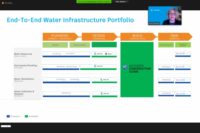
Bentley Systems recently launched a new design product that automates the creation of digital twins for telecom towers. OpenTower iQ gives designers and contractors 3D visualization and predictive design for utility towers. It enables data captured by drones to be brought into 3D models and lets users incorporate artificial intelligence to inform design decisions using Bentley's iTwin cloud service.
"The tower operators are extending their service to 5G and need to re-simulate and constantly reconfigure their assets for new devices," says Greg Bentley, the technology firm's CEO. "They start literally with drone surveys for their existing inventory, they use machine learning to recognize the components in their digital libraries," and then they can simulate how wind loads affect the structural aspects of their designs, he adds.
In a wide-ranging interview after his appearance at the McKinsey Global Infrastructure Initiative Summit, held virtually April 6-8, Bentley said the demand for virtual delivery of design and the automation of physical construction is already increasing, a trend that will continue as the world begins to recover from the COVID-19 pandemic.
"During the pandemic, allowing users to inspect, improve and maintain resilience remotely was needed," Bentley says. "You'll see we have more products specifically for this purpose that add machine learning to a digital twin. The same principle and the same software platform—our iTwin cloud service—we'll apply elsewhere."
Bentley said that much of the technology needed to allow designers and contractors to create wholly predictive digital twins of all types of infrastructure assets already exist, but creating workflows that allow engineers and contractors to use them most efficiently could use refinement.
"Drones themselves and better cameras, scanners that can be mounted on drones and moved around to produce the overlapping video and scans that go into our software that produces the digital twin reality mesh representation, that obviously applies perfectly to infrastructure assets," Bentley says. "This is a quick and efficient way through software to produce the 3D representations, engineering-ready ... we just have to take advantage of that."
Bentley sees an entirely new opportunity beyond project delivery for engineering firms to be the proprietor, creator and curator of digital twins for owners for their existing assets. Engineers could offer proprietary analytics services, he says, to "look across all such assets and create insights and formulas for improving resilience and throughput." Two asset categories that would most benefit, Bentley says, are water and energy.
Report Finds Water Utilities 'Insight Poor'
A recent study conducted by Bentley in conjunction with Dodge Data & Analytics showed potential for water utilities to use data that’s already being collected to help address chronic and growing needs. The report, "The Digital Capabilities of U.S. Water Utilities SmartMarket Brief," shows that 87% of water utilities collect data, and of those that do, only 50% are gathering even half the data available—and that data is often siloed.
"We become data rich, but insight poor,” says Gregg Herrin, vice president, water infrastructure at Bentley Systems. Implementing digital twins would be one way to integrate the data in a more meaningful way. “Oftentimes, the operations part of a utility barely speaks to the engineering team, except maybe when there is a problem,” he adds. The study found that only 4% of the utilities surveyed have very good or excellent capabilities for leveraging digital twins.
Resistance to change (70%) and not understanding where to invest in digital technologies (66%) are two of the biggest barriers that keep water utilities from investing more in digital solutions, according to the report. The resistance comes in part from the conservative nature of water utilities, which have such a huge impact on public health, Herrin said.
An aging workforce is another problem, he says. But as workers retire, that will become less of a problem. A younger workforce is likely to think “It’s strange that you wake up in the morning and check your news on your phone, look at the weather … check traffic. And then you get to work and look at paper charts.”
Water utilities resistance to using data is not a surprise. Still, Bentley wanted to team with Dodge to ensure they were looking at the whole picture objectively, so that they, in turn, could share the data and “inspire some utilities,” to encourage their own digital transformation, Herrin says.
Steve Jones, senior director of industry insights for Dodge Data & Analytics, adds, “We find consistently in our research that people are at the heart of a successful adoption of new technology. The technology is the tool, but … the real value comes from the insights it provides to help them to do their work more effectively.”
In a related example, Brown and Caldwell recently announced it has entered into a partnership with analytics provider Seeq to help better use the data already being collected by water utilities to optimize systems and processes and to detect changes in the systems. Brown and Caldwell has already used the Seeq analysis tools at Utah’s Central Valley Water Reclamation Facility where digital analysis found that its disinfectant dosing wasn’t as efficient as it could be, and instead implemented a UV treatment process that is saving the utility $185,000 a year.






Post a comment to this article
Report Abusive Comment